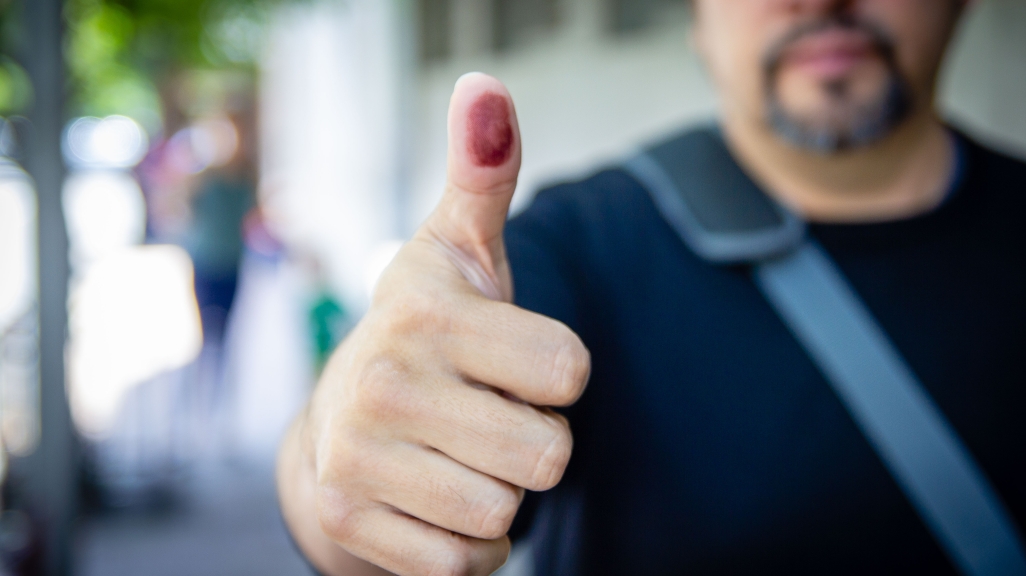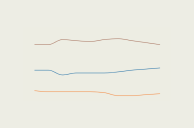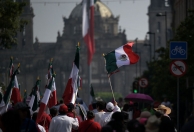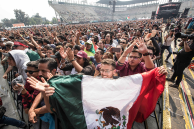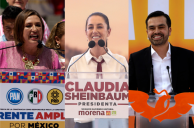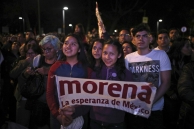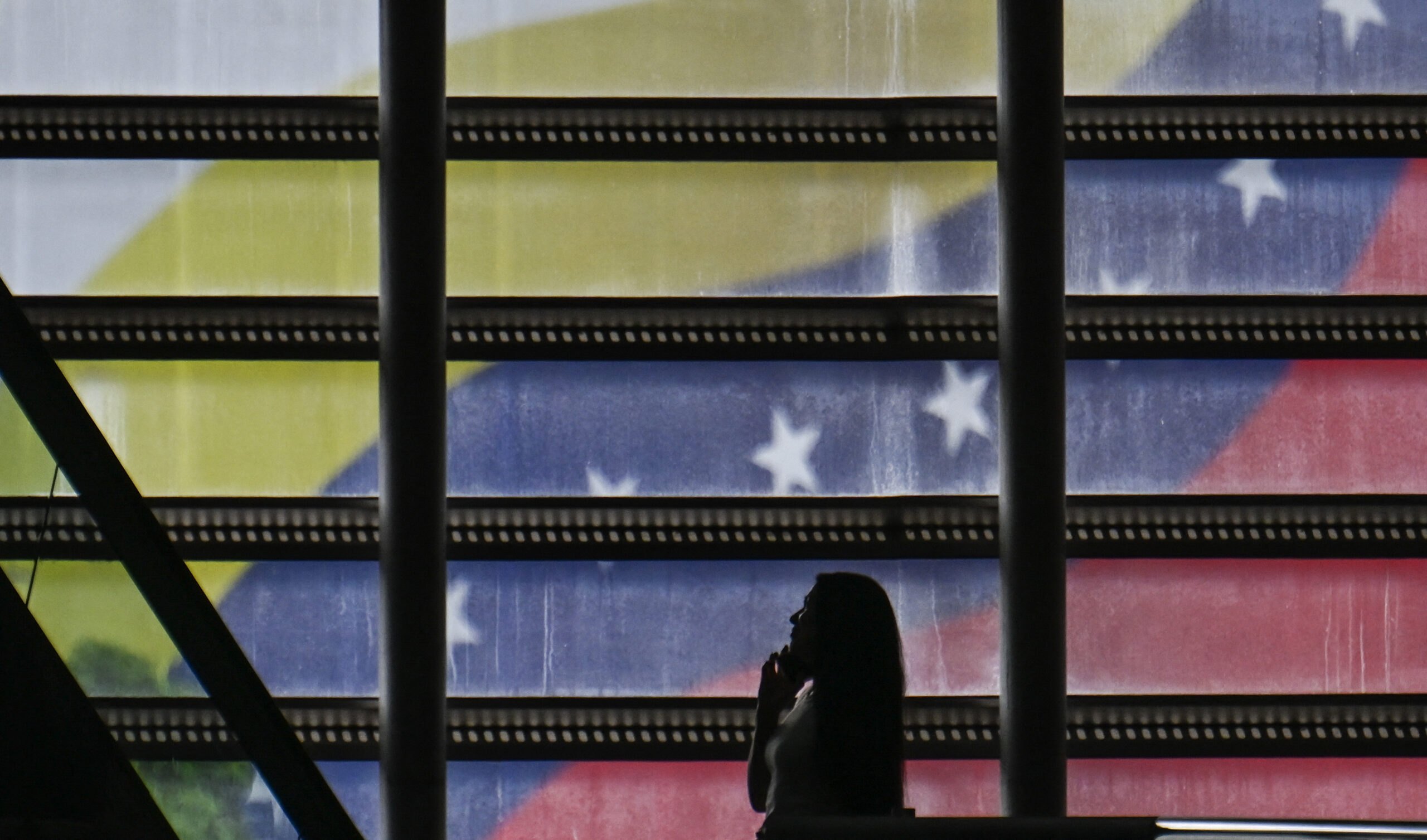Mexico Elects: Ongoing Coverage of the 2024 Race—The Results Are in
Mexico Elects: Ongoing Coverage of the 2024 Race—The Results Are in
Get updates on Mexico's giant elections, right up through the outcome of the June 2 vote.
Initial coverage was originally published on December 7, 2023. New content is regularly added.
With more than 20,000 posts up for grabs on June 2, Mexico’s 2024 general elections will reshape the country’s political landscape. And the results are in: Mexico will have its first woman president. Claudia Sheinbaum of the governing Morena's alliance will replace popular President Andrés Manuel López Obrador when he finishes his single, six-year term on October 1. She defeated Xóchitl Gálvez of the opposition PAN-PRI-PRD alliance and Jorge Álvarez Máynez of the Movimiento Ciudadano (MC).
Through ongoing updates, explainers, and poll tracking, AS/COA Online has covered this electoral cycle with regular coverage.
The biggest winner since 1982. With 91 percent of the vote reported, Claudia Sheinbaum has won Mexico’s presidency with a commanding 59 percent of the vote. That’s 30 points more than her closest rival, Xóchitl Gálvez, a former senator of the National Action Party (PAN) and candidate of the main opposition alliance. It’s also more than the 53 percent her predecessor and political mentor President Andrés Manuel López Obrador, or AMLO, won in 2018. And, it’s the largest share of the vote captured since 1982—a time when Mexico was not considered a free and fair democracy.
Sheinbaum outperformed polling expectations, which placed her around 54 percent, while Gálvez underperformed by about six points, per Oraculus’ polling aggregator. The third candidate in the race, Jorge Alvárez Máynez of the Citizens Movement, captured about 10.5 percent of the vote, roughly in line with estimates.
With 91 percent of votes counted, turnout in the race was 60 percent, down from 63 percent in the previous presidential contest.
All but Aguascalientes. Sheinbaum won all but one of Mexico’s 32 states and federal entities—the same number as López Obrador captured in 2018. It was only in Aguascalientes, the twenty-seventh most populated state, that she didn’t triumph. Gálvez won there by 4 percentage points.
Sheinbaum did pick up Guanajuato, the one state that AMLO lost in 2018 and long-considered a PAN stronghold. Her margin of victory was 6 percent there. In all but three states, she won by commanding double digit margins, capturing 50 to even 80 percent of the votes in some cases.
Superclose to a supermajority. Morena had its eyes on winning two-thirds of Mexico’s Senate and Chamber of Deputies, which would enable it to pass López Obrador’s proposed 20 constitutional amendments.
In the Chamber of Deputies, Morena, along with allies the Green Party of Mexico and the Workers Party, is predicted, in the most conservative scenario, to have 346 seats out of 500, 10 more than needed for a supermajority. They may have up to 380. In the Senate, Morena’s coalition is projected to capture between 76 and 88 of 128 seats. That may place them below the 85 they need for a qualified majority. Either way, given Mexico’s tradition of politicians switching party affiliation, Morena could still be able to capture the few extra seats needed to achieve a supermajority.
Morena’s gubernatorial grab. Of the nine governorships in play in this election, Morena not only kept the six its alliance held, but added another one—the formerly PAN state of Yucatán. Also included in that gubernatorial tally is head of government of Mexico City, a high profile post both Sheinbaum and López Obrador held, and the highly populated states Puebla and Veracruz. That latter state was expected to be a close race, but former Energy Secretary Rocío Nahle won commandingly with about 60 percent of the vote.
Morena won a tight race in Yucatán, which was previously governed by the PAN, while triumphing with over 60 percent margins in southern states like Chiapas and Tabasco. Morena will now control 24 of Mexico’s 32 governorships. Six years ago, it controlled just four.
Which states are eschewing Morena rule? Jalisco was won for the second time in a row by the Citizens’ Movement. And Guanajuato elected its first first woman governor, Libia García Muñoz Ledo, marking a continuation of PAN rule dating back to 1991. —Chase Harrison
Claudia Sheinbaum, Xóchitl Gálvez, and Jorge Álvarez Máynez are competing for the presidency. See polls ahead of the June 2, 2024 election.
Candidates across the country wrapped up their campaigns on May 29 as Mexico entered a three-day period designed to promote voter reflection before Sunday’s elections. Claudia Sheinbaum, the leading candidate, closed her campaign with a rally just where she started it—in the emblematic location of the capital's famous, giant main square, called the Zócalo. She pledged that she would not defraud her voters and said: “I promise to give you my soul, my life, and my very best for the good of the people of Mexico.” She also said she will keep on the path of her political mentor, saying: “I will maintain the legacy of President Andrés Manuel López Obrador.”
Force and Heart for Mexico candidate Xóchitl Gálvez ended her own campaign with stops in the most populous state in the country, Estado de Mexico, and the northern state of Nuevo León before a final event close to midnight in her home state of Hidalgo. There, in her hometown of Tepatepec, she announced that “the soul of Mexico” is at stake in the election.
During the stop in Nuevo León, Sheinbaum’s main contender asked supporters: “Are you ready to vote and defend life? Are you ready to vote and defend liberty? Are you ready to vote and defend the truth?” Gálvez, who started her campaign in Fresnillo, Zacatecas—the town with the highest levels of perceptions of insecurity in Mexico—also said: “They’re shaking with fear in the National Palace because they know that we, the good ones, are larger in number and that we’ve had enough.”
In addition, she attacked the governor of Nuevo León Samuel García and called him and his party, Citizen’s Movement, corrupt.
Meanwhile, the MC’s candidate Jorge Álvarez Máynez closed his campaign with a party-style rally seeking to connect with the group his campaign has focused on throughout the election: young voters. In a festival of rap, rock, and punk and dubbed the Máynez Capital Fest, the candidate said: “We want to thank you for what you’ve done, for showing the country that said the youth are apathetic, that we’re a generation of crystal millennials, that we’re a generation of crystal centennials, that we showed them that it's not that we don’t care about politics—we just don’t care about their politics.” The event took place in an auditorium in Mexico City.
But despite the celebrations and rallies, tragedy also struck the close of campaigns. José Alfredo Cabrera Barrientos, a Force and Heart for Mexico mayoral candidate in Coyuca de Benítez, Guerrero, was shot in the back at his final campaign event. The murder took place in despite the presence of National Guard members there to provide protection.
At least 32 candidates have been killed during this campaign cycle and some 750 candidates, officials, and their family members have been victims of some form of aggression—ranging from kidnappings to attacks to murders—since September 2023.—Carin Zissis
Beyond the presidential race, contests for nine governorships and Congress will shape the nation’s political future.
Election day may be on June 2, but Mexicans living outside the country could already cast their ballots starting on May 18. In terms of sheer numbers, it’s already been a record year for voters registered abroad. Still, given that Mexico has the world’s second-largest population living abroad, its rate of expat voting runs low.
Roughly 12.2 million Mexicans live outside of the country. In 2023, they sent home over $63.3 billion in remittances, accounting for 3.5 percent of Mexico’s GDP.
But while this group exercises economic power, its electoral might is limited. Only 1.4 million—or about 12 percent—are on the voter roll. In order to cast a ballot, they must go through a process of confirming credentials. About 675,000 citizens abroad have done so, according to INE, Mexico’s electoral agency. Those voters must then take the step of registering for each election.
About 225,000 citizens did so for this round, meaning less than 2 percent of Mexicans abroad. Compare that to the Dominican Republic, the last Latin American country to hold election—a case in which some 18 percent of voters abroad participated in its May 19 vote.
What accounts for the gap? Journalist Jorge Ramos blames the complexity of registration. And all three presidential candidates agree. Registration requires the presentation of several documents and involved a February deadline for June elections. This cycle, registration was extended five days to accommodate interest.
The difficulty of the process was on full display when, in April, the INE removed around 40,000 voters from the roll—nearly 1 in 6 registered abroad—due to what they said were irregularities in their credentials. After criticism from the three presidential campaigns, the INE reinstated nearly 36,000 of those voters.
On a positive note, the number of Mexicans casting ballots abroad keeps rising. One reason to the upward trajectory is likely to continue is that voters have more options. This will be the first presidential election in which Mexicans abroad have three ways to cast their ballot. Previously, diaspora voters could only participate via mail-in ballot. This year, they will be able to vote online (an option used in state elections in 2021 and 2023) and in person at one of 23 selected consulates (an option debuted in 2023.) Per INE, over two-thirds of the voters opted for an online ballot and a quarter selected to use a mail ballot.
All but three of the consulates where voting will take place are in the United States, where 97 percent of registered Mexicans abroad live. Same-day registration is allowed at these consulates.—Chase Harrison
The ballots have been printed. The clock is ticking down. And polls give the ruling party’s Claudia Sheinbaum more than a 20-point lead over Xóchitl Gálvez, her next closest rival. With just over two weeks to go, is there any way the opposition can win?
Some say the best path involves unifying forces. During a media interview this week, Luis Donaldo Colosio Riojas, a senate candidate for the Citizen’s Movement (MC) in Nuevo León state, urged for the candidate polling third in the race to back down and help form “a responsible opposition.” Though Colosio did not specify which candidate he was referring to, his own party’s presidential contender, Jorge Álvarez Máynez, places a distant third at roughly 10 percent. Colosio, whose father was assassinated while running for president 30 years ago and who himself has been eyed as an eventual presidential hopeful, released a message on May 14 voicing support for his party’s proposals and candidate. But he added that “our Mexico is bigger than any party” and called on Gálvez and Máynez to come to an agreement for the future of the country.
At various points in the competition, Gálvez and key figures in her Fuerza y Corazón por México coalition have invited the MC to join their alliance, but the fact that such a proposal won support from a prominent voice within Máynez’s party raised more than a few eyebrows. After Colosio’s interview, Alejandro Moreno—head of the PRI, one of the parties in Gálvez’s coalition—said he would step down from his leadership role and give up his bid for a senate seat if Máynez bows out by May 19, ahead of the third and final presidential debate. Moreno urged Máynez to dedicate his radio and television time to making a call for a unified vote.
Máynez responded by mocking Moreno’s pitch as a sign of “desperation.” He has frequently criticized Moreno, a controversial figure tied to corruption scandals and whose leadership has coincided with the ongoing shriveling of the party that once dominated Mexican politics. He also made a counteroffer to quit the race after the debate if the PRI selects Beatriz Paredes, previously one of the leading presidential contenders, to take Moreno’s place as the party’s leader. Integralia’s Luis Carlos Ugalde argues that many view the MC as an accessory to the ruling Morena party in that it divides the opposition vote, which is why Máynez will not give up.
Even if Máynez does not decline, the past few days have seen growing debate surrounding voto útil, or the strategic vote. Should voters pick their top choice regardless of viability or should they unite behind one candidate to try to defeat the frontrunner? Senator Patricia Mercado, another prominent MC voice, made the case for the former. She said young voters in particular would be without an option “that’s closer to their convictions” if the race doesn’t include Máynez, who draws his greatest support from millennial and Gen Z voters. Prominent pollster Roy Campos of Mitofsky argued that, at this point in the competition, a Máynez decision to duck out would not be enough to change the outcome, particularly as the ballots have already been printed.
What else is happening on May 19? On the same day as the third debate, protesters opposed to proposed reforms to the country’s autonomous electoral agency (INE) plan to take to the streets again on Sunday with a major demonstration in Mexico City. Known as the Marea rosa (“pink tide”) movement, marchers don the pink used in the INE’s logo in defense of an institution they say President López Obrador has sought to undermine. Indeed, AMLO’s government attempted to usher through a reform last year known as Plan B that involved major cuts to the INE’s staff and budget. The Supreme Court stalled the reform.
In the past, the protests have drawn hundreds of thousands of demonstrators in defense of the INE’s autonomy, as well as the judiciary’s independence. But while the marches’ organizers previously identified their demonstrations as non-partisan, Gálvez, who adopted pink as a campaign color, and Santiago Taboada, the Fuerza y Corazón por México mayoral candidate in the capital, will be the May 19 protest’s main speakers. On Tuesday May 14, Marea rosa coordinators endorsed Gálvez and urged for voto utíl.
What do you need to know about the final presidential debate? For one thing, the INE modified the format days ahead of the forum. Read our debate tracker for more. —Carin Zissis
The election may be slated for June 2, but more than a quarter of a million young Mexicans took part in a dry run of the vote on May 7. For the first time, roughly 400 universities across the country held electoral simulations, held in part to boost youth participation in the electoral process, and students, teaching staff, and other members of the academic community participated. Claudia Sheinbaum took the top spot with 63.5 percent compared with Jorge Álvarez Máynez second at 23.1 percent and Xóchitl Gálvez in third at 8.5 percent.
That Sheinbaum, the electoral frontrunner, landed first may come as little surprise, but Máynez’s second-place finish drew attention, given that he has consistently polled a distant third. Then again, his party’s target has been the youth vote. At 38, he is more than two decades younger than his rivals and tends to draw his strongest support—though barely above 10 percent compared with his rivals—among Gen Z and millennial voters. For her part, following Tuesday’s results Gálvez called on young voters to “waken up,” warning that the next 30 years of their lives are in play in this election.
Meanwhile, organizers of the practice run called on the candidates to note that “the university community is the country’s motor of development and, for that reason, we deserve to be heard and prioritized in your visions for governing.” Nearly half of Mexico’s voters are under the age of 40, but younger voters often have lower turnout rates. One reason is that candidates pitch proposals with older voters in mind, Me Veo’s Alexandra Zapata told AS/COA Online in a recent Latin America in Focus episode. Zapata, whose organization focused on getting out the vote in this election, said: “I think what would be extraordinary—and the way we can increase voter participation in June of 2024—is if campaigns turn and look at young voters and what they're concerned about.”
And what are young Mexicans worried about? The lack of job opportunities, as well as issues such as low salaries and high crime, per a February Expansión Pólitica/University of the Valley of Mexico poll of 18 to 29-year-olds. Overall, those polled said they felt excluded by (64 percent), unenthusiastic about (68 percent), and mistrustful of (73 percent) politics in Mexico. They also appear to be disenchanted with political parties, given that 69 percent say the parties are in crisis and 60 percent it’s better to vote for distinct parties for different roles rather than down the party line. The youth’s lack of commitment to any one political group is notable in a country where one party dominated politics for most of the twentieth century.
Despite the sense of discontent, there is a reason to be hopeful about young Mexicans’ democratic participation. Nearly 82 percent of the Gen Z participants polled said they plan to vote on June 2. —Carin Zissis
Nearly half of Mexico’s voters are under 40. Me Veo’s Alexandra Zapata and LAPOP Lab’s Noam Lupu join our second 2024 election series episode.
During the week of April 22, Council of the Americas (COA) hosted Claudia Sheinbaum for an exclusive program. In a conversation with COA President and CEO Susan Segal, the presidential candidate for the Let’s Keep Making History alliance said that USMCA review required working in partnership with the private sector. Watch the video below.
AS/COA also hosted a conference on April 23 with Economy Secretary Raquel Buenrostro, Finance Secretary Rogelio Ramírez de la O, and Ildefonso Guajardo, coordinator for international issues for opposition candidate Xóchitl Gálvez. Watch their participation, as well as panels with private and public-sector leaders.
In the ten years since its official registration as a political party, Morena together with its allies—has come to control the gubernatorial seats of 23 out of Mexico’s 32 states. But will it continue to expand its territorial control this year? Perhaps not.
Nine states are up for grabs on June 2. Morena’s alliance currently governs six of them: Chiapas, Mexico City, Morelos, Puebla, Tabasco, and Zacatecas. The National Action Party (PAN) controls Guanajuato and Yucatan while Movimiento Ciudadano (MC) governs Jalisco. Across the polls, the incumbent party leads in each state. In some cases, Morena hold a clear advantage, such in the southern state of Chiapas and in President Andrés Manuel López Obrador’s home state of Tabasco. In others, polls indicate tight races, such as in MC-controlled Jalisco or PAN-run Yucatán.
The elections are still far enough out that news events could have an impact on outcomes. That’s because, as pollster Lorena Becerra told AS/COA Online ahead of the official campaign season: “A greater part of the electorate [starts] paying attention closer to the election.” And in this election cycles, there’s no lack of news—both nationally and in the states. In the case of the race to govern oil-rich Veracruz, Morena candidate Rocío Nahle has found herself embroiled in a scandal over a luxury properties she purchased while serving as energy minister. She argues she is the victim of dirty campaigning.
In Mexico City, the interim mayor Martí Batres—seen as a close ally of the Morena candidate Clara Brugada—drew criticism over his dismissal of reports of tainted water supply in some areas of the capital at a time when the city’s water shortages are a major campaign issue.
In a recent analysis, Citibanamex argues that Morena will hold on to Chiapas, Puebla, and Tabasco while the opposition will keep Guanajuato, Jalisco, and Yucatán. But the firm suggested that in Morelos could switch into the opposition’s hands, given that outgoing Governor and former soccer star Cuauhtémoc Blanco faces high levels of disapproval. The analysis predicts a loss for Morena in Veracruz and a fierce competition in Mexico City.
Whatever the electoral outcomes, Mexico could soon have more gobernadoras. Under Mexico’s political parity laws, the electoral agency requires that parties nominate women candidates in five out of nine competitions. Ten Mexican states are currently governed by women. —Carin Zissis
Whether debates can make a difference in the outcome of an election is, well, a matter of debate. On one hand, the forums can help voters make better-informed decisions at the ballot box and engage with the electoral process in a manner that deepens democracy. On the other, many observers contend that unless a candidate has a disastrous performance, debates are unlikely to affect results.
In the case of Mexico, the question of whether debates matter is unclear in a race where polls give Claudia Sheinbaum of the governing Morena alliance a roughly 25-point lead over her closest rival, Xóchitl Gálvez of the PAN-PRI-PRD opposition coalition. A third candidate, MC’s Jorge Álvarez Máynez, lands a distant third with roughly 6 points of support.
Mexico has been holding presidential debates for 30 years, starting with the 1994 elections. There are signs debates have had an impact on the trajectory of the country’s races, even if they didn't change the final outcomes of the last two presidential votes of 2012 and 2018. Moreover, some have speculated that Gálvez has a down-to-earth nature that matches that of current President Andrés Manuel López Obrador—a trait that could help her on the debate floor against Sheinbaum’s dry style. Still, Sheinbaum’s polling allows the former Mexico City mayor to take the stage with the confidence of someone with a big head start in the competition.
The three presidential debates take place April 7, April 28, and May 19 in Mexico City. AS/COA Online summarizes the themes, formats, and outcomes of each forum.
Claudia Sheinbaum, Xóchitl Gálvez, and Jorge Álvarez Máynez sparred in three debates. AS/COA Online tracks the topics and formats of each.
10 weeks to go. Speculation about who might succeed Mexican President Andrés Manuel López Obrador has been going on pretty much since he took office in 2018. Now we’re in the final weeks until the June 2 election day and governing party candidate Claudia Sheinbaum maintains a formidable poll lead.
But what will she do if she wins? In a candidate explainer by Chase Harrison, we look for clues in her prior role as Mexico City mayor, cover how her main rival Xóchitl Gálvez rose to the top of the opposition pool, and explore what role Jorge Álvarez Máynez—trailing with single-digit support—plays in the race.
Learn about Claudia Sheinbaum, Xóchitl Gálvez, and Jorge Álvarez Máynez—the three rivals competing to succeed Andrés Manuel López Obrador.
While Mexico’s presidential competition rightfully draws the greatest attention in the country’s massive elections, the race to govern the capital arguably takes the silver as the second-most important electoral battle. On March 17, voters will get a window into that competition, when mayoral candidates Clara Brugada of Morena, Santiago Taboada of the FAM alliance, and Salomón Chertorivski of the MC participate in their first debate. The competition could also provide insights into the overall election.
Background. The Mexico City mayoralty serves as a launching pad for presidential candidacies, whether it be President Andrés Manuel López Obrador or current frontrunner Claudia Sheinbaum. Whoever ends up in the role will not just be overseeing the political center for the federal government, but the entity that at 14.5 percent accounts for a greater share of national GDP than any of the other 31 states.
Moreover, Mexico City’s voters have a history of bucking national trends. When, in 2000, Mexico leaned right to elect Vicente Fox president during the country’s democratic transition, the capital selected leftist AMLO. The city had already veered left when it picked Cuauhtémoc Cárdenas in 1997, and its mayors have stayed that way ideologically for over a quarter-century ever since. For much of the country, electing AMLO in 2018 meant choosing an anti-incumbent. But capitalinos had already been governed by officials associated with his political parties—first the PRD and then Morena—for more than two decades.
Then, in 2021 midterms, a city long seen as a bastion of the left showed signs of a shift—or, at a minimum, a divide. While Morena’s alliance won seven largely working-class districts to the east, the opposition took the nine largely middle-class and wealthier districts to the west. All told, the governing alliance lost four seats. The losses placed doubts about Morena’s future control of the mayoralty.
The current competition. The east-west divide has carried over into the current mayoral competition, as well as reflecting a sense of polarization at a national level. Brugada, who previously governed populous working-class district Iztapalapa, leads El Financiero polling with 44 percent. Taboada, who governed the Benito Juárez district, stands at 36 percent. National Deputy Chertorivski polls at 7 percent. But, even if Brugada is ahead overall, Taboada leads in the western half of the city. While she is stronger among voters with basic education and lower social classes, he performs better among university-educated voters and is nearly on par with Brugada when it comes to the middle class.
That gives Brugada a smaller lead than Sheinbaum’s national advantage. Interestingly, Brugada wasn’t the party’s top choice candidate for the race. Omar García Harfuch, who was Sheinbaum’s pick, won an internal poll to be Morena’s contender for the capital, and many viewed him as a stronger candidate to compete in the opposition’s middle-class territory. However, due to gender parity rules, Brugada—seen as AMLO’s favorite—was nominated. And rumors exist of a chilly relationship between Brugada and Sheinbaum.
Even still, Brugada’s proposals mirror Sheinbaum’s presidential platform in an indication that Morena is seeking to present party unity, with a focus on anti-corruption, social programs, and maintaining the city’s security policies. Taboada, meanwhile, has based his platform on five pillars: security, water, transportation, healthcare access, and economic opportunities. As the three candidates spar in Sunday’s debate, pressing issues such as water shortages and a decaying subway system will be important topics. —Carin Zissis
It may seem like the Mexican elections have been going on for ages, but the official campaigns finally start on March 1, spanning a three-month period until election day.
Where will each candidate kick off her or his official campaign, and what’s the significance of each location?
Frontrunner Claudia Sheinbaum plans to launch her campaign in the place where she was born, raised, and grew her political career: Mexico City. The former mayor will do so at 4 pm local time in the capital’s giant central plaza, or Zócalo. In doing, she is not only selecting a historic site surrounded by the National Palace and Aztec ruins but a location known for mass gatherings, political and cultural events, and protests. Governing Morena party leader Mario Delgado said that the event will not only mark the beginning of Sheinbaum’s campaign, but also “send a message to President [AMLO] that the people are with him.”
Xóchitl Gálvez, meanwhile, chose Fresnillo in the state of Zacatecas to kick off her campaign at midnight. Gálvez says she chose the location because residents there have Mexico’s highest levels of perceptions of insecurity, with some 97 percent of the city’s inhabitants saying they feel unsafe when it comes to crime. Fresnillo has become a battleground in a turf war between two cartels.
In choosing the city, Gálvez draws attention to an issue seen as a weak spot for the popular AMLO government. Per a February poll, 71 percent of Mexicans say they disapprove of his government’s handling of public security matters.
Later on Friday, Gálvez plans to continue her launch tour with a stop in the city of Aguascalientes (in the state of the same name) followed by a large event in Irapuato, Guanajuato. That state is a stronghold of Gálvez’s PAN party, and it was the only state out of Mexico’s 32 that AMLO lost in the 2018 presidential vote.
Jorgé Álvarez Máynez will also shine a spotlight on violence concerns when he initiates his campaign in Lagos de Moreno in the state of Jalisco. The city has not only been an epicenter of violence but was home to five young men who were kidnapped in August 2023 in a case that drew national attention due to a horrific leaked video of their murder. Both the city and the state are governed by Álvarez Máynez’s party, Citizen’s Movement.
Overall, the issue of insecurity is casting a shadow over the official start of campaigns amid fears that political violence and intimidation by organized crime groups will shape the outcome of elections. Learn more: In its February 29 episode, weekly podcast Política y Otros Datos digs into concerns about political violence and corruption in this electoral round. Another podcast series by N+, Política Déjà Vu, covers the history of political violence in Mexico.
One last look at the polls before we begin. Polling remains fairly steady since Sheinbaum and Gálvez’s presidential hopes were cemented in the summertime, with poll aggregator Oraculus giving Sheinbaum (63 percent) more than a 30-point advantage over Gálvez (31 percent). Álvarez Máynez trails well behind at 5 percent.
Will there be a spring surprise? We will be monitoring to find out the answer. Bookmark our poll tracker and election guide for updates. —Carin Zissis
Presidential frontrunner Claudia Sheinbaum’s platform took shape this weekend, though not exactly by her own doing. On February 5—a Mexican holiday celebrating the anniversary of the country’s 1917 Constitution—President AMLO unveiled a package of 20 reforms covering areas ranging from energy to pensions to animal rights. With 18 of the measures requiring constitutional reforms, it’s expected they will face major hurdles getting the required two-thirds congressional majority needed to pass. But, as we noted on January 18, by presenting the reforms before the official start of campaigns in March, the president sets the agenda for electoral talking points.
Moreover, AMLO’s move charted a roadmap of issues for his potential successor, Sheinbaum, to follow should she win and carry on the political legacy of his movement, known as the Fourth Transformation. A day after he shared his reform package, she revealed that she would launch her official campaign with a March 1 event in Mexico City’s main plaza to defend his 20-point plan.
So, what’s in the package? Proposals cover a wide range of topics and include banning fracking and open-air mining, prohibiting vaping and chemical drugs such as fentanyl, limiting water concessions in drought-affected areas, and converting privatized railways used for cargo into passenger lines.
But some proposals are gaining extra attention, such as a reform that would see retirees earn pensions equivalent to 100 percent of their salaries at the end of their careers. Another eliminates the federal legislative seats determined through proportional representation, thereby reducing the number of lower house members from 500 to 300 and halving senatorial seats from 128 to 64. The reform would see members of electoral agencies selected through direct election. It would also reduce the portion of voters needed to validate referendums—including presidential recall votes—from 40 percent to 30 percent. Other reforms would see direct election of Supreme Court justices and the elimination of autonomous regulatory bodies handling areas such as transparency, telecommunications, and energy. Finally, his proposals include a measure that would make austerity a matter of state policy.
Reforms covering areas such as pensions and railways seek to undo changes made by preceding governments that AMLO frames as neoliberal. Others replicate some of his failed reforms—particularly his proposed changes to electoral agencies, which sparked widespread protests in 2023. Now, observers warn that the reforms would weaken checks and balances, whether by giving the governing party more presence in Congress, granting control over electoral agencies back to the ruling party, or making sitting presidents more vulnerable to recall votes. Sheinbaum defended the proposals, saying they boost social and human rights.
The other side’s pitch. Meanwhile, a document obtained by El Universal in late January outlines a draft platform for the opposition coalition and, as the Mexican outlet says, much of it seeks “to revert a large part of what has been carried out by the AMLO administration.” Proposals include restoring daycare programs—as well as the trade and investment promotion agency ProMéxico—and overhauling of state oil firm Pemex. On the security and justice front, the alliance pledges that the National Guard would be an agency under civil command and the penitentiary system would be reformed, as would police training. In addition, the coalition would seek to conduct a deep evaluation of the AMLO government’s cornerstone infrastructure projects, such as the Maya Train in the Yucatán Peninsula and the Dos Bocas refinery in Tabasco.
Speaking of states. Polls.mx is monitoring races across the board, including in the nine gubernatorial competitions taking place. At this time, Morena’s coalition leads in six, including in Mexico City, considered the crown jewel of the 32 states. The opposition Frente Amplio por México alliance is a handful of points ahead in Guanajuato and Yucatán. Citizen’s Movement holds a two-point lead in another key state, Jalisco.
Polls show close races in a number of instances and official campaigns are not yet underway, making it too early to predict outcomes. But, if results ended up mirroring current polling, incumbent parties and alliances would win.—Carin Zissis
Two new polls came out this week, and they’re not exactly telling the same story. Enkoll’s poll shows Sheinbaum solidifying her lead, rising five points to 54 percent. Gálvez saw an increase of four points to 27 percent. But, with Álvarez Máynez at the helm, the MC saw a 14-point drop in support to just 3 percent.
El Financiero’s polls, on the other hand, show Sheinbaum dropping four points to 48 percent in an apparent gain for Álvarez Máynez, who rose to 10 percent. Perhaps even more notable is the MC’s six-point gain in polling for the lower house of Congress. Why does it matter? The party previously voted with the opposition in Congress, but some of its players—Álvarez Máynez included—have been increasingly critical of the PAN and the PRI, leading many to wonder if the party could swing to Morena’s side in the future. With 11-percent support, polling suggests it could become the third-biggest party in the Chamber of Deputies—and a political bloc that either side will seek to win over.
But a key difference between the polls is Sheinbaum’s lead. In Enkoll’s, she’s ahead by 27 points. El Financiero, however, has her ahead by 16. Writing in Nexos, Jorge Castañeda covers the discrepancy, differences between polling methods, and why the two disagree on whether or not “the rice is cooked” in election terms. El Financiero’s pollster, Alejandro Moreno, meanwhile, argues that past elections show the biggest swings in Mexican presidential polling have typically taken place in the spring, when official campaigns are underway.
Claudia “energizes” her campaign. Sheinbaum unveiled a major plank of her campaign: a promise to get over 50 percent of Mexico’s energy grid powered by renewable energy. “Mexico has to accelerate its energy transition,” she said, while signaling an openness to private investment.
Xóchitl’s Morning Rebuttals. One of the mainstays of AMLO’s sexenio has been his mañaneras, his daily morning news conferences in which he speaks off-the-cuff to an audience of mainly reporters. Gálvez announced on January 25 that she would be doing her own version, dubbed, “truth conferences,” to rebut AMLO’s morning address each day of the inter-campaign period, which ends February 29. —Carin Zissis and Chase Harrison
For the past two months, presidential aspirants have been making their initial cases to supporters during pre-campaigns, despite not yet being official candidates.
With that period wrapping up, Mexico’s electoral agency (INE) laid out the schedule for the presidential debates during the official campaign season, which runs from March 1 to May 29. In a shift to centralization from prior electoral rounds, all three debates will be held in the capital. The first, on April 7, will feature questions taken via social media. The second, on April 28, will allow for direct questions from the audience. The third, on May 19, is described as a “face-to-face between candidates” to focus on interaction between the contenders. The INE requires all official presidential candidates to participate.
But even as debate agenda was set, opposition candidate Xóchitl Gálvez challenged the incumbent party’s Claudia Sheinbaum to a debate before the pre-campaigns' end on January 18. Gálvez—who noted the discussion should focus on the major challenges of healthcare, corruption, and security—implied Sheinbaum may need to get permission from AMLO to participate. Sheinbaum responded that “a lot of provocation won’t lead to a rise in the polls,” alluding to Gálvez’s trailing poll numbers.
As this period of the electoral cycle closes, it appears pre-campaign activities have had limited impact on the polls, which continue to give Sheinbaum’s Morena coalition a more than 20-point lead over Gálvez’s Broad Front. Jorge Álvarez Máynez’s Citizen’s Movement trails far behind.
Meanwhile, AMLO announced that he plans to introduce 10 reforms to Congress on February 5. The proposals will shape the electoral agenda, given that candidates at various levels will find themselves campaigning for or against AMLO’s reforms. Perhaps the most controversial of the proposals involves a judicial reform that would see direct election of Supreme Court justices, and it comes at a time when the Court has proven to be a counterbalance to executive powers. Other reforms gaining attention include one that would seek to give retirees pensions equivalent to their full salaries while another proposal would shut down autonomous oversight agencies.
What comes next? From January 19 until the start of the official campaigns on March 1, the contenders cannot promote their candidacies, but they can attend interviews and events. Political parties can air general messages. In addition, the INE will audit spending of the parties and candidates during this period. The presidential hopefuls will officially register their candidacies from February 15 to 22. It is expected that Sheinbaum, Gálvez, and Álvarez Máynez will be the three candidates.—Carin Zissis
One big question has loomed over Mexico’s pre-campaign period: Besides the two women representing the country’s main coalitions, will anyone else be on the presidential ballot in June? We now have the answer.
On January 9, Nuevo León Governor Samuel García, who saw his own presidential hopes dashed last month (see the December 7 post), revealed his substitute to be the pre-candidate for the Citizen’s Movement (MC) party: Jorge Álvarez Máynez, his former campaign coordinator. In an X post targeting younger voters, García shared a video in which he’s having a beer with Álvarez Máynez, who is donning orange sneakers—an MC trademark pioneered by García’s wife, Mariana Rodríguez, who also appears in the post. “We’re going to show Mexico and the old way of doing politics that they have messed with the wrong generation,” said García.
Indeed, at 38, Álvarez Máynez would be the youngest of the candidates by more than two decades. Still, the Zacatecas native has been involved in politics since he was 18, when he affiliated himself with AMLO’s former party, the PRD. Over the years, he hopped from one party to another, holding his first major political post as leftist legislator for the PRI in his home state from 2010 to 2013, during which time he presented initiatives to decriminalize abortion and same-sex marriage. In 2013, he joined the MC and, most recently, served as a federal deputy and the party’s coordinator in the lower House of Congress.
On January 10, the MC officially registered the pre-candidacy of Álvarez Máynez, but García’s social media reveal had already sparked jokes about the young deputy's lack of name recognition. Regardless of that challenge, the MC polls a distant third in Mexico’s presidential race. Still, he is viewed as a close ally of party head Dante Delgado. Competing in the election would elevate his name him in line to take over MC leadership when Delgado steps down.
While the MC will vie for the presidency, the ballot will lack an independent candidate. No independent contender was able to secure enough signatures to qualify. Hard-right hopeful Eduardo Verástegui secured the largest number, but still garnered just 14 percent of the nearly one million needed by the January 6 deadline. There will also be no independent candidates for senator. However, there will be nearly 15 independent aspirants for the Chamber of Deputies, and nearly half of them—seven—will be on the ballot in the state of Hidalgo.—Carin Zissis
The two main institutions charged with overseeing elections in Mexico have faced recent internal battles raising concerns about their ability to perform their functions with less than six months to go. In early December, the electoral court known as the TEPFJ—which is charged with settling electoral disputes and certifying results—experienced a controversial leadership change when its president, Reyes Rodríguez Mondragón, was pressured to hand in his resignation by a group of fellow ministers. On December 15, a majority of court members elected another minister, Mónica Soto, to lead the tribunal. Amid speculation that she has ties to the ruling Morena party, Soto herself cast the tie-breaking vote in her favor. She assumes leadership on January 1.
Meanwhile, the National Electoral Agency (INE)—the top institution handling electoral processes—has witnessed a flurry of senior-level resignations. This also comes amid claims of a divide between allies and opponents of INE President Guadalupe Taddei. She ascended to her role in April 2023 amid a polarized struggle in which López Obrador sought to reform the agency. Thousands took to the streets nationwide to protest his efforts.
Speaking of allies and opponents, despite the fact that the PRI is part of the opposition alliance, a group of high-profile PRI members announced their support for the candidacy Morena’s Claudia Sheinbaum on December 19. The 18 priistas—some of whom had already exited the party previously— launched what they call “the progressive alliance,” which includes former Governors of Oaxaca Alejandro Murat and of the State of Mexico Eruviel Ávila.
The pre-campaign event scorecard: Near the midway point in the pre-campaigns, Animal Político reports that Gálvez has canceled 29 percent of her events, holding 49 since the period began. Sheinbaum has held 168 and plans to hold another 192 by the time pre-campaigns end on January 18.—Carin Zissis
When Xóchitl Gálvez announced her presidential bid in June 2023, she entered the race with a bit of a hue of an outsider. Though she represented the National Action Party (PAN) in the Senate, she was not officially a member of any particular political party and many wondered from where she would source her campaign team. “If she becomes the candidate, it’s going to be incredibly hard for her to put together a campaign team that works and that represents all the people that are supporting her,” political analyst Carlos Bravo Regidor told Americas Quarterly at the time.
On December 5, Gálvez revealed her complete team, made up of 24 people from the three parties in the Broad Front for Mexico (or FAM) coalition. Key names include campaign manager Santiago Creel, a long-time PAN member and former legislator who was a presidential aspirant earlier this year. Two former official presidential candidates are also on the team: Senator Josefina Vázquez Mota, who ran as the PAN candidate in 2012, and former First Lady Margarita Zavala, who ran as an independent in 2018. Prominent names from the Institutional Revolutionary Party (PRI) include ex-Foreign Secretary and former presidential aspirant this year Enrique de la Madrid—charged with overseeing the proposed plan for her government and former Economy Secretary Ildefonso Guajardo, who will focus on foreign affairs. Below is the full list announced December 5, 2023:
- Santiago Creel, campaign manager
- Armando Tejeda, head of operations
- Carolina Viggiano, executive coordinator
- Ángel Ávila, alliance coordinator
- Kenia López Ramadán, head of the pre-candidate’s office
- Rubén Moreira, coordinator of national territories
- Maximiliano Cortázar, coordinator of social communication
- Josefina Vázquez Mota, coordinator of campaign leaders
- Margarita Martínez Fisher, coordinator of voting campaigns
- Jesús Ortega Martínez, strategic coordinator
- Margarita Zavala, lead on civil society
- Enrique de la Madrid, lead on government plan
- Norma Aceves, lead on attention for people with disabilities
- Fernando Rodríguez Doval, content coordinator
- Alejandra Latapí, coordinator of institutional ties
- Ildefonso Guajardo, lead on foreign relations
- Alejandra Reynoso, lead on social causes
- Blanca Alcalá Ruiz, lead on migration issues
- Leticia Barrera Maldonado, lead on rural ties
- Alessandra Rojo de la Vega, lead on social activism
- Julieta Camacho Granados, lead on social management
- Deborah Romero Vázquez, lead on women’s issues
- Moisés Gómez Reyna, lead on agenda
In addition, Gálvez announced that her two children, Diana Vega Gálvez and Juan Pablo Sánchez Gálvez, will have—per the candidate—unpaid social media roles.
For her part, frontrunner Claudia Sheinbaum announced her team on November 27. The list is made up of big names in the governing Morena party’s Together We Make History alliance, such as former Interior Minister and close AMLO ally Adán Augusto López as her political coordinator; Gerardo Fernández Noroña, an outspoken former legislator for the Labor Party, as social organizations coordinator and spokesperson; and ex-Senator Ricardo Monreal as national territory coordinator. Mario Delgado, the Morena party president, will serve in the role of campaign manager. Tatiana Clouthier, former economy minister and an important figure in AMLO’s 2018 campaign, is making a notable comeback as spokesperson coordinator. Below is the full list announced November 27, 2023:
- Mario Delgado, pre-campaign coordinator
- Adán Augusto López, political coordinator
- Ricardo Monreal, coordinator of national territories
- Gerardo Fernández Noroña, coordinator of social organizations and pre-campaign spokesperson
- Jesús Valdez Peña, coordinator of international organizations and Mexicans abroad
- Tatiana Clouthier, coordinator of spokespeople
- Citlalli Hernández, coordinator of the alliance
- Renata Turrent, coordinator of ties with the academic community
- Regina Orozco, coordinator of ties with the cultural community
- Esthela Damián, tour coordinator
In addition, on December 3, Sheinbaum announced a strategic team made up of 17 specialists who are charged with, among other things, overseeing forums on major policy issues. Coordinated by former Mexican Ambassador to the UN Juan Ramón de la Fuente, team members include economist Gerardo Esquivel; former PAN Governor of Chihuahua Javier Corral; Sheinbaum’s ex-chief of public security in Mexico City Omar García Harfuch; former Interior Minister Olga Sánchez Cordero; former head of the Supreme Court Arturo Zaldívar; business leader Alta Gracia Gómez Sierra; and historian Lorenzo Meyer.
In other news, following Nuevo León Governor Samuel García’s failed bid to be the presidential candidate for the Citizen’s Movement, his wife, Mariana Rodríguez, announced that she will seek to be a candidate to be mayor of Monterrey, the state’s capital. (See the post from December 7 below for more. —Carin Zissis
Samuel García, 35, seemed like a competitive presidential candidate in the making. As the governor of business-friendly border state Nuevo León, he proudly displays JFK memorabilia in his office. He and his wife, Mariana Rodríguez, document their lives on social media—birth of their daughter included. Though he polled third among presidential candidates, García drew his strongest support from the country’s sizable youth voting bloc.
But just a few days after launching his pre-campaign, his state descended into chaos due to a dispute over who would step in temporarily as governor during the six-month period that he would compete for the presidency. The state legislature, controlled by the Institutional Revolutionary Party (PRI) and National Action Party (PAN), selected the interim governor, which would have meant García’s Citizens’ Movement (MC) party would lose executive control of the state.
Faced with that setback and a legal deadline for him to vacate the governorship, García decided to reinstate himself and Nuevo León woke up on December 2 with two governors. That afternoon, he officially withdrew his presidential bid. By the end of the first week of December, interim Governor Luis Enrique Orozco has ceded the governorship back to García, who is in the second year of a six-year term.
Not only did the turmoil wreak havoc on Nuevo León’s state politics, but it left the MC without a presidential aspirant. Party leader Dante Delgado indicated on December 4 that the party could potentially name another candidate in January. Two days later, he announced that the MC would exit the opposition’s bloc in the Senate, which includes the PRI, PAN, and Party of the Democratic Revolution. That bloc served as a legislative counterbalance to the governing party’s Morena coalition. The move stoked speculation that the MC is increasingly aligning with López Obrador and Morena. —Carin Zissis
Pollster Lorena Becerra and political scientist Javier Aparicio explain the meteoric rise—and the 2024 electoral test—for President AMLO’s political party.
Mexico’s 2024 election will be the biggest in the country’s history. That’s not just due to the sheer number of voters but because—for the first time—all 32 of the country’s states will hold concurrent elections for local seats, in addition to the presidential contest. Mexican voters will cast ballots for more than 20,000 posts across the country. That’s about six times the number of posts up for grabs during the last general elections in 2018.
The year 2024 also marks a decade since governing party Morena officially registered as a party. In the 10 years since, Morena has become the leading political force in the country with popular President Andrés Manuel López Obrador as its figurehead.
With an eye to the country’s massive vote on June 2, 2024, AS/COA Online maps out the electoral calendar, the positions up for grabs at the federal and state level, what’s at stake in the gubernatorial races, and the demographics of the electorate.
Read the full article and access charts mapping the race.—Carin Zissis and Jon Orbach







